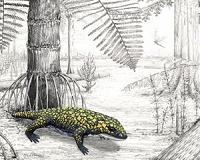| . |  |
. |
Ottawa, Canada (SPX) Mar 19, 2010 Scientists have unearthed the remains of one of the Worlds rarest fossils - in downtown Ottawa. The 450 million year old fossil preserves the complete skeleton of a plumulitid machaeridian, one of only 8 such specimens known. Plumulitids were annelid worms - the group including earthworms, bristleworms and leeches, today found everywhere from the deepest sea to the soil in your yard - and although plumulitids were small they reveal important evidence of how this major group of organisms evolved. "Such significant new fossils are generally discovered in remote or little studied areas of the globe, requiring difficult journeys and a bit of adventure to reach them" notes Jakob Vinther of Yale University, lead author of the paper describing the specimen. "Not this one though. It was found in a place that has an address rather than map co-ordinates!" Plumulites canadensis, Albert Street, Ottawa, Canada K1P1A4. The fossil is described by Vinther and Dave Rudkin, of Toronto's Royal Ontario Museum, in the current issue of the journal Palaeontology. It was Rudkin who first recognised its scientific significance: "This nifty little specimen first came to my notice when I received a letter from an amateur fossil collector in Nepean, Ontario. In prospecting for fossils in rock from a temporary building excavation he had turned up a small block containing a complete trilobite, but next to it was something else and he sent me a slightly fuzzy but very intriguing photo. "The mystery fossil was clearly not another trilobite, and I although couldn't be certain, I thought it might be some sort of annelid worm with broad, flattened scales. James, the collector, generously agreed to lend me the specimen and I realised immediately it was a complete, fully articulated machaeridian! The first I had ever seen." At that time it was not known that machaeridians were annelids. "James was happy to donate the specimen to the Royal Ontario Museum, in exchange for a promise that I'd someday publish his discovery." It was not until 2008 that Rudkin's hunch was confirmed, when a team of palaeontologists, including Jakob Vinther, decribed new machaeridian fossils from remote mountain localities in Morocco, revealing their relationship to annelid worms. Rudkin and Vinther agreed to work together to interpret the Ottawa specimen, and it is the results of that collaboration that are published in the current Palaeontology. Plumulitid machaeridians look like modern bristleworms, with stout walking limbs bearing long bundles of bristles, but on their back they carried a set of mineralized plates. According to Vinther, "the plates themselves were rigid, but they could move relative to one other, providing plumulitids with a protective body armour very similar to the flexible metal armour invented by humans 450 million years later. Machaeridian body armour is unique among annelids, and probably helped them to succeed as ubiquitous components of marine ecosystems for more than 200 million years." With the publication of this paper Rudkin is finally able to make good on his promise "It's great to be able to acknowledge the collector", says Rudkin, but there is a twist to this tale: the man who found the specimen has now gone missing. "Regrettably, I lost contact with James and numerous enquiries as to his whereabouts have come up empty. I hope he somehow gets wind of all this."
Share This Article With Planet Earth
Related Links Yale University Explore The Early Earth at TerraDaily.com
 Early Terrestrial Amphibian Was Carnivorous
Early Terrestrial Amphibian Was CarnivorousPittsburgh PA (SPX) Mar 16, 2010 A team of researchers from Carnegie Museum of Natural History has described a new genus and species of carnivorous amphibian from western Pennsylvania. The fossil skull, found in 2004 near Pittsburgh International Airport, was recovered from rocks deposited approximately 300 million years ago during the Late Pennsylvanian Period. Named Fedexia striegeli, it is one of only a very few relati ... read more |
|
| The content herein, unless otherwise known to be public domain, are Copyright 1995-2010 - SpaceDaily. AFP and UPI Wire Stories are copyright Agence France-Presse and United Press International. ESA Portal Reports are copyright European Space Agency. All NASA sourced material is public domain. Additional copyrights may apply in whole or part to other bona fide parties. Advertising does not imply endorsement,agreement or approval of any opinions, statements or information provided by SpaceDaily on any Web page published or hosted by SpaceDaily. Privacy Statement |